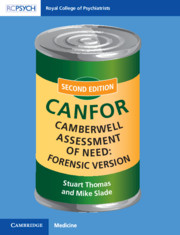Book contents
- Camberwell Assessment of Need: Forensic Version
- Camberwell Assessment of Need: Forensic Version
- Copyright page
- Contents
- Acknowledgements
- Abbreviations
- Chapter 1 Introduction
- Chapter 2 Needs Assessment
- Chapter 3 Development of the Camberwell Assessment of Need Forensic Version (CANFOR)
- Chapter 4 Practicalities of Using the CANFOR Scales
- Chapter 5 Using the Camberwell Assessment of Need Forensic Research Version (CANFOR-R)
- Chapter 6 Using the Camberwell Assessment of Need Forensic Clinical Version (CANFOR-C)
- Chapter 7 Using the Camberwell Assessment of Need Forensic Short Version (CANFOR-S)
- Chapter 8 Translations of the CANFOR
- Chapter 9 Suggested Training
- Chapter 10 Frequently Asked Questions
- Book part
- References
- Index
- References
References
Published online by Cambridge University Press: 13 April 2021
- Camberwell Assessment of Need: Forensic Version
- Camberwell Assessment of Need: Forensic Version
- Copyright page
- Contents
- Acknowledgements
- Abbreviations
- Chapter 1 Introduction
- Chapter 2 Needs Assessment
- Chapter 3 Development of the Camberwell Assessment of Need Forensic Version (CANFOR)
- Chapter 4 Practicalities of Using the CANFOR Scales
- Chapter 5 Using the Camberwell Assessment of Need Forensic Research Version (CANFOR-R)
- Chapter 6 Using the Camberwell Assessment of Need Forensic Clinical Version (CANFOR-C)
- Chapter 7 Using the Camberwell Assessment of Need Forensic Short Version (CANFOR-S)
- Chapter 8 Translations of the CANFOR
- Chapter 9 Suggested Training
- Chapter 10 Frequently Asked Questions
- Book part
- References
- Index
- References
Summary

- Type
- Chapter
- Information
- Camberwell Assessment of Need: Forensic VersionCANFOR, pp. 111 - 113Publisher: Cambridge University PressPrint publication year: 2021

